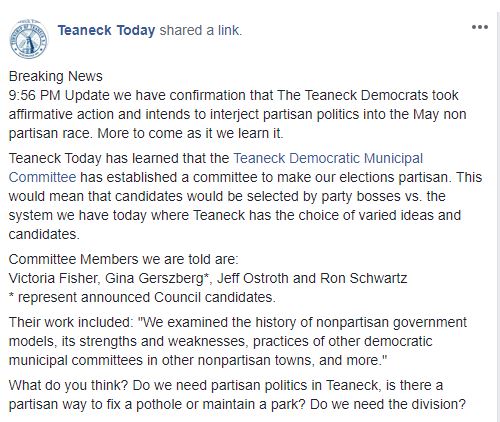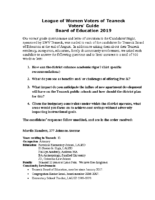In last May’s Atlantic, Jonathan Haidt has a very powerful article in which he talks about ways to “harden democratic institutions“.
I encourage you to read it in full. One topic he covers is how to “reduce the outsize influence of angry extremists and make legislators more responsive to the average voter”.
He notes:
“One example of such a reform is to end closed party primaries, replacing them with a single, nonpartisan, open primary from which the top several candidates advance to a general election that also uses ranked-choice voting.”
Teaneck already is non-partisan without primaries, so we are 2/3 of the way there. We should adopt ranked-choice voting.
Ranked-Choice-Voting
In 2019, NY’ers went to the polls and brought “Ranked Choice Voting” to the Empire State. The measure had nearly 74% of the votes cast in favor and it went into effect starting in 2021.
We should follow their lead. We wouldn’t be the first in NJ (Hoboken did so last year) and it wouldn’t go into effect until the State legislature authorizes RCV in the Garden State. But like Hoboken, we can have it ready to go.
The ballot question will be triggered if and when the state government passes legislation that enables municipalities to adopt RCV, an option not available under current state election law.
Not only would this be a blow to those with entrenched power in the highest State offices, but the benefits would also be seen all the way downstream to Town Council and Board of Education spots.
It would be great to get this everywhere in New Jersey, if possible — but even Teaneck would do well switching to RCV.
How Ranked Choice Balloting works:
“In ranked-choice elections, voters don’t pick just their favorites. They’re also allowed, though not required, to rank everyone else on the ballot in order of preference. If no candidate wins a majority the first time around, there’s an instant runoff. The candidate who garnered the fewest first-place votes is dropped. The votes he or she got are transferred to whoever the voters listed next on their ballots. The process continues until someone gets a majority. Here’s a diagram showing how it worked in Maine’s Democratic gubernatorial primary in 2018.”

Our current elections tend to see turnout in dismal numbers.
Board of Education election in non-Presidential years show: 7,617 voters or 25.66% out of over 27,000+ who are registered. Even Council elections in November show a substantial drop-off from Federal to local ballots, as trends from other towns show.
We used to do much better.
And for those that did come out, a number of factors, including some strategic thinking, tend to penetrate choices in the ballot box.
To learn why Ranked Choice Voting would benefit us, let’s take a step back and see how we arrived where we are.
March 16th, 1895: Teaneck incorporates with a 3 member Township Committee
“A meeting of the Township Committee was held at the Teaneck Chapel, for the purpose of organizing. Meeting called to order by Ex-Township Clerk Cornelius Terhune at 11 a.m. who formally turned over to The Township Clerk the Ballot Box Certificate of returns of Election and Poll Clerk’s Affidavit.
The members of the Town Committee were duly sworn by the Township Clerk, who then formally called the meeting to order.”
Skipping forward a bit…. as the town got larger, the Council became 5 and eventually 7 members.
In 1962, 17 men ran for Council. At the time, all council positions were elected at the same time.
These are the vote totals (winners are highlighted):
| Candidate |
Votes |
|
Candidate |
Votes |
| Sherwood Bradford Menkes |
7057 |
|
Matthew Feldman |
8400 |
| James P. Tarras |
2896 |
|
Thomas J. Costa |
8268 |
| Max A. Hasse, Jr. |
7672 |
|
Robert Holmes Henderson |
4089 |
| William W. Brett |
3080 |
|
John Einberger |
1503 |
| John K. Walsh |
5933 |
|
George Gori |
1488 |
| Morris Cohen |
3088 |
|
John A. Lee |
1935 |
| Howard Siegel |
2499 |
|
William J. Russell |
2079 |
| Samuel P. Bartoletta |
6192 |
|
Harry W. Wolf |
2607 |
| William E. Baker |
2116 |
|
|
|
With roughly 42,000+ residents, with the exception of one person, the winners had between 5,933 and 8,400 votes.
53 percent of eligible voters came out and 70,902 votes were cast.
At the next election, in 1966, the vote totals started to rise (winners highlighted):
| Candidate |
Votes |
|
Candidate |
Votes |
| Sherwood Bradford Menkes |
5698 |
|
John K. Walsh |
5667 |
| Robert H. Henderson |
4436 |
|
Marian Cerf |
4315 |
| Max A. Hasse, Jr. |
6271 |
|
Isaac G. McNatt |
4368 |
| William Brett |
3619 |
|
Morris Cohen |
1828 |
| Lawrence Wolfberg |
4041 |
|
Samuel Goodstein |
1728 |
| John P. Dougherty |
4691 |
|
Bernard J. Bergton |
2740 |
| Thomas J. Costa |
6051 |
|
Kivie Dornfeld |
2709 |
| Francis E. Hall |
4848 |
|
Peter F. Zeleny |
2588 |
| Rolf Feder |
4114 |
|
|
|
48 percent of eligible voters came out and cast 69,712 votes.
| Year |
Percent of registered voters casting ballots |
| 1958 |
42% |
| 1962 |
53% |
| 1966 |
48% |
Another concern expressed by Mayor Feldman at the time was the use of “bullet voting“.
“To those who did come out, but who voted for less than seven candidates, I also want to express my concern. Many people did not use all their seven votes; the total of available votes shows a discrepancy of 5,902 votes from the total of potential votes for all 17 candidates. That’s almost 6,000 wasted votes.
I suspect that this bullet voting is motivated in large part by the commonly held belief that the high man in .the voting is entitled ·to the post of mayor. For that reason, I am seriously considering a change in the election law which would separate the candidates for Mayor from the candidates for Council. I believe that this might at least reduce the, amount of bullet voting.”
Increasing participation and voter turnout have been vexing problems to solve.
It could very well be that some people wish not to be bothered. It could also be the case that some people are so satisfied with the administration of our community, and therefore did not bother to vote.
Whatever the reasons, various tweaks were contemplated over the years, including staggering elections (which would happen in 1988), and even moving to a ward system, as a way of motivating people to come out to the polls (this was rejected).
November 3, 1987:
Voting on a public question to adopt staggered elections for seven members of council, the results were:
| In Favor |
4408 |
| Opposed |
4230 |
And that brings us to our present form of voting. When we went to the polls this November, did you vote for all four candidates? The numbers show a significant numbers of votes available to people showing up, we’re not cast.
Today, bullet voting continues due to strategic voting by residents.
Did you bullet vote to ensure your top one or two candidates were the ones that didn’t get eliminated by your third pick edging them out of the win column?
The beauty of ranked-choice-voting is that these issues get eliminated. There is no longer a benefit to bullet voting, and those who may not be your “strategic” pick, can still be your reasoned choice.
This gives us benefits and has virtually no drawbacks.
We should insist NJ adopt it or put it on the ballot for a referendum by the people.
NY was 74% in favor. I think we can do better.











